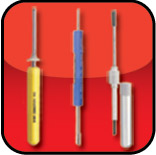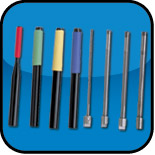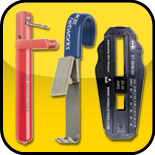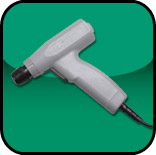WIRE WRAP TOOLS
WIRE WRAP TOOLS
Information on How to Wire Wrap and Unwrap Terminals
The technology of wire wrapping was developed by Bell Labs in the late 1940's as a new interconnection system for their local exchange facilities or Central Offices. It is still popular with electronics and telecommunications applications. Before the development of wire wrapping, the common method for making a wire connection was soldering which resulted in a variety of complications for applications in which it was used.
Wire wrapping is a mechanical interconnection technology that provides more safety and reliability. Jonard-OK Industries has developed a line of wire wrap bits and sleeves, wire wrap guns and hand wrapping tools specifically designed for wire wrapping terminals. Jonard copper wire strippers are ideal for such copper interconnect applications. Some of these wire strippers feature the ability to cut and strip wiring to the appropriate wire wrapping length. Once an installer or technician removes wire insulation, they're ready to begin.
Wire wrapping terminals involves connecting stripped copper wires to the sharp corners of terminals to complete electrical circuits. A rotating element, such as a Jonard - OK Industries wire wrap tool, is used to coil the bare wire tightly around the terminal using a large amount of tension and compression forces, resulting in a gas-tight and corrosion-safe connection.
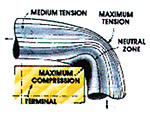
Metal to Metal Contact
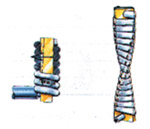
High-Pressure Contact
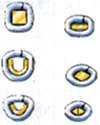
Terminals Suitable for
Wire-Wrapped Connections
This technique limits electrical and telecommunication connections to their basic mechanical elements – the terminal and wire used. See the general diagram on how to make wire wrapped connections below. Detailed instructions on how to finish the connection will be dependent on the wire wrapping tool selected for the job.
How to Wire Wrap Terminals
Select the proper bit and Sleeve for the Wire Being used

Insert the terminal

Insert the wire into the Wire Slot

Finished connection

Anchor the Wire

Modified Wire Wrapping vs Regular Wire Wrapping
Wire wrapped connections are designed in two primary ways, which are known as regular and modified. The difference is that while a regular connection uses un-insulated wire only, the modified version adds about one and a half turns of insulated wire. This is especially important where the diameter of the wire used is small, which may result in mechanical instability.
This means the size of the wire used will help to determine the wrapping method to use. As a rule of thumb, a standard wrap is used with wires whose diameters are 26 AWG larger while a modified wrap is generally used with 28 or 30 AWG wires. As far as electrical characteristics are concerned, both types of wire wrapping yield a resistance that is below 3 ohms. They only affect the mechanical stability of the connections.

Regular Wire Wrap

Modified Wire Wrap
Some Hints on Making Wrapped Wire Connections
Easy Does it!
Do not press to hard. Let the OK tools do the work. Excessive pressure cap lead to overwrapping. Backforce "BF" to prevent overwrapping is available on most power tools and it's recommended for use with 26 through 30 AWG wire.
Overwrap
Stay With It!
Just keep the OK tool on the terminal until the wrap is complete. Early removal can result in spiral and open wraps.
Open Wrap
Spiral Wrap
Feed Wire Correctly!
It's easy to lead wire into the slot in the OK bit correctly. Be sure the stripped end of the wire is "pushed in" all the way.
Insufficient Turns
Use the Correct Bit and Sleeve!
Wire wrapping is a precision technique and the wrong bit and sleeve just can not do the job. Improper selection can cause problems ranging from "Pigtails" to loose wraps.
Pigtail
The Importance of Wire Wrap Tool Selection
While wire wrapping technology is basically the same in different applications, the tool used will affect several areas, including ergonomics, efficiency and cost. Jonard OK-Industries manufactures quality wire wrap guns, wire wrap hand tools, wire wrap bits and sleeves – and more. The important things to consider when choosing the right tool are:

- Gauge of the wire to be used. This includes the diameters of both the wire itself and the insulation.
- Terminal diagonal, which is the diagonal distance between opposite wire wrap posts.
- Effective radius, which is the radius that both the bit and sleeve cover as they rotate.
- Terminal depth
- How many wire wraps and unwraps are required for the job
Jonard OK Industries Hand wire wrap and unwrap tools are the cheapest and simplest wire wrapping option. These wire wrap tools look like ordinary screw drivers and wire wrapping or unwrapping is achieved by twisting them by hand. Their bits and sleeves are usually part of the tools themselves, which means they are used for particular wire gauge sizes. They are generally useful for prototyping or repair work. However, they are not ideal for performing over 50 wrap operations in one day, which is where a manual wire wrap tool comes in handy.

Manual wire wrap tools, from Jonard OK Industries, are ideal for between 50 and 200 wire wrap jobs per day. Going beyond this limit may lead to such complications as repetitive stress and operator fatigue. In cases where the electrical wiring is live, it is advisable to use an aluminum manual wire wrap tool. The nose piece should be tightened when the trigger is squeezed to minimize drag and ensure the wire wrapping bit and sleeve (sold separately) are properly oriented.

For applications requiring more than 200 operations per day, it is better to use Jonard OK Industries electric wire wrap guns or battery-powered wire wrapping tools. In addition to providing a higher level of efficiency, these tools protect the operator from injuries associated with repetitive stress in high volume applications.
The choice between battery-powered and electrical powered tools is largely a matter of individual preferences. The electric powered tools should not be used where there is compressed air. Operators with relatively less experience may benefit from using the 'back-force' option, an available option on the Jonard OK Industries PTX 1-BF wire wrap gun, which prevents over-wrapping by absorbing some extra pressure exerted by the operator. Back-force is recommended for 26 AWG to 30 AWG wires.
Jonard PTX Series Wire Wrap and Unwrap Power Tool Instruction Video
The Speed Myth
Many people believe that the speed of the tool used determines how effective a wrap becomes. However, this is a misconception. A wrap made slowly using a hand tool may be of the same quality as that made by using a power tool making more than 4000 revolutions per minute (RPM). The speed does not affect the action and geometry of the bit face, which pull wires with the required tension to provide consistent electrical and mechanical integrity.
Since wire wrapping is a precision technique, it is important to choose the right tool for the required application.

